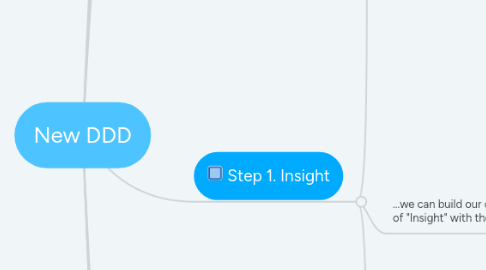
1. Course Notes
1.1. ...course materials and tools...
1.1.1. Mindmeister
1.1.1.1. ...link to this board...
1.1.1.1.1. http://bit.ly/2ZV1CQT
1.1.2. Jamboards
1.1.2.1. ...team boards...
1.1.2.1.1. Team #1
1.1.2.1.2. Team #2
1.1.2.1.3. Team #3
1.1.2.1.4. User Guide
1.1.2.2. ...demo board...
1.1.2.2.1. Demo Board
1.1.3. Data
2. Framing: Data and Design
2.1. ...key considerations...
2.1.1. Design Processes
2.1.1.1. ...design is a process that relies on insight...
2.1.1.1.1. The Design Thinking Process
2.1.1.2. ...different processes work with insight in different ways and deliver different outcomes as a result...
2.1.1.2.1. Design Thinking for Service Design
2.1.1.2.2. Six Sigma for Process Design
2.1.1.3. ...there is no single design process that fits all contexts and purposes...
2.1.1.3.1. Design Processes
2.1.2. Data for Design
2.1.2.1. ...design is increasingly data driven...
2.1.2.1.1. Kayak A-B Tests
2.1.2.2. ...when we consider how and when data will be used in the design process, we need to consider the context...
2.1.2.2.1. The Cynefin Model
2.1.2.3. ...we also need to consider our purpose, are we "exploring" or "confirming"...
2.1.2.3.1. Experimental Design
2.1.2.4. ...we can see efforts to balance these considerations in holistic design processes...
2.1.2.4.1. IBM Loop Design Process
2.1.3. Data in Design
2.1.3.1. ...increasingly, data is core to the mechanics of the design itself...
2.1.3.1.1. German Rail
2.1.3.1.2. Personetics
2.1.3.1.3. Triggr Health
2.1.4. Data and Design
2.1.4.1. ...the design discipline is increasingly showing a blend of design processes, with data sciences strongly featured...
2.1.4.1.1. "Uber Engineering is committed to developing technologies that create seamless, impactful experiences for our customers..."
3. Theme: Design in Transport
3.1. ...designing solutions for urban travel in the age of the "smart city"...
3.1.1. Singapore Future of Mobility
3.1.1.1. ...more detail...
3.1.1.1.1. Future of Urban Transport
3.1.1.1.2. Deloitte, Future of Mobility
3.2. ...an initial "design direction"...
3.2.1. We are city leaders tasked with designing a solution for urban congestion...
4. Two Views
4.1. ...throughout the course we are going to explore the similarities and differences between two design approaches...
4.1.1. Design Thinking
4.1.1.1. ...steps...
4.1.1.1.1. Empathise
4.1.1.1.2. Define
4.1.1.1.3. Ideate
4.1.1.1.4. Prototype
4.1.1.1.5. Test:
4.1.1.1.6. Implement
4.1.1.2. ...guides...
4.1.1.2.1. d.school Bootleg
4.1.1.2.2. IDEO Design Thinking Process
4.1.1.2.3. Nielsen Norman Group
4.1.2. CRISP
4.1.2.1. ...steps...
4.1.2.1.1. Business Understanding
4.1.2.1.2. Data Understanding
4.1.2.1.3. Data Preparation
4.1.2.1.4. Modelling
4.1.2.1.5. Evaluation
4.1.2.1.6. Deployment
4.1.2.2. ...guides...
4.1.2.2.1. Uber Michelangelo Design Process
4.1.2.2.2. Tibco CRISP
4.1.2.2.3. CRISP-DM Standard
5. Step 1. Insight
5.1. ...the design processes we are focussing on approach this step in different ways...
5.1.1. Design Thinking
5.1.1.1. ...steps...
5.1.1.1.1. Empathise
5.1.1.1.2. Define
5.1.2. CRISP
5.1.2.1. ...steps...
5.1.2.1.1. Business Understanding
5.1.2.1.2. Data Understanding
5.2. ...we can build our capabilities in the area of "Insight" with the following tools...
5.2.1. System Exploration
5.2.1.1. ...exploratory tools that allow unknown unknowns to be revealed...
5.2.1.1.1. Journey Mapping
5.2.1.1.2. Reality Charting
5.2.1.1.3. Heuristic Assessment
5.2.2. Data and Feature Mining
5.2.2.1. ...a process of "exploratory data analysis" proceeds any data initiative...
5.2.2.1.1. EDA helps us to uncover the underlying structure of the dataset, identify important variables, detect outliers and anomalies, and test underlying assumptions...
5.2.3. Design Challenges
5.2.3.1. ...sharpening the design process based on what has been learned...
5.2.3.1.1. A design challenge articulates the problem you are trying to solve, and helps you define a scope that is neither too narrow nor too broad...
5.3. ...reflection...
5.3.1. Exploration
5.3.1.1. ...the qualitative exploration can aid the definition of system "features" and guide the next stage of data capture...
5.3.1.1.1. Qualitative Exploration
5.3.2. Confirmation
5.3.2.1. ...the quantitative confirmation can bring confidence and direction to the design process...
5.3.2.1.1. Exploratory and Confirmatory Research
5.3.3. Sensing and Sensemaking
6. Step 2. Ideation
6.1. ...typically the ideation phase of a design process will incorporate forms of brainstorming based on gathered insight and inspiration...
6.1.1. Design Thinking Double Diamond
6.2. ...we will focus on exploring how machine learning techniques may guide our thinking with regards to ideation...
6.2.1. Supervised Machine Learning
6.2.1.1. Supervised learning is the machine learning task of learning a function that maps an input to an output based on example input-output pairs...
6.2.1.1.1. ...context...
6.2.1.1.2. ...machine learning algorithms are distinguished by their workflow and application...
6.2.1.2. In Excel
6.2.1.2.1. ...we can get to grips with regression and supervised learning in Excel...
6.2.1.3. In Jamovi
6.2.1.3.1. ...Jamovi is a leading GUI for R that gives us more power for our regressions...
6.2.1.3.2. ...we can make a start by replicating the Excel analysis in Jamovi...
6.2.1.3.3. ...we can leverage Jamovi's advanced tools to develop our understanding of regression...
6.2.1.3.4. ...the process for Logistic Regression is broadly similar...
6.2.1.4. In BigML
6.2.1.4.1. ...an example of a big data, low code machine learning platform...
6.2.1.4.2. ...increasingly, we find machine learning being automated...
6.2.1.5. ...reflection task...
6.2.1.5.1. Gather a set of high level ideas for reducing congestion in an urban transport system...
7. Step 3. Implementation
7.1. ...when it comes to implementation, we can contrast the "learning by doing" methods of design thinking with the quantitative "proofs" of the data sciences...
7.1.1. Design Thinking
7.1.1.1. Prototype
7.1.1.1.1. ...highlight...
7.1.2. CRISP
7.1.2.1. Evaluation
7.1.2.1.1. ...highlight...
7.2. ...tools...
7.2.1. Blueprints and Logic Chains
7.2.1.1. Service blueprints visualize organizational processes in order to optimize how a business delivers a user experience...
7.2.1.1.1. ...overview...
7.2.1.1.2. ...example...
7.2.1.1.3. ...extension...
7.2.2. Experimentation
7.2.2.1. ...establishing whether ideas "work" or judging which ideas and options "work best"...
7.2.2.1.1. Experimental Design
7.2.2.1.2. In Jamovi
8. Reflection
8.1. ...for discussion...
8.1.1. Do the tools from Design Thinking and CRISP support each other?
9. Notes and Additions
9.1. AI Engagement
9.1.1. https://marvelapp.com/blog/automate-user-testing-process/
9.1.2. https://www.uxmatters.com/mt/archives/2018/04/the-future-of-ux-design-is-automation.php
9.1.3. https://cux.io/
9.1.4. https://www.trypencil.com/
9.1.5. https://personetics.com/
9.1.6. https://www.socialpinpoint.com/
9.1.7. https://mopinion.com/
9.1.8. https://usabilla.com/
9.1.9. https://www.pointillist.com/
